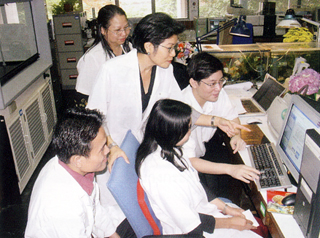

 Professor Dr. Nateetip Krishnamra
was born on June 1, 1951 in Bangkok.
She received her primary and the
first phase of her secondary education
at Wattana Withayalai School in Bangkok
before going for further education
at Ashford School, Kent, England
where she completed the G.C.E. O’
and A’levels. She received her B.Sc.
in Biological Sciences with first
class honours from Westfield-Queen
Mary College, London University in
1974. After returning to Bangkok,
Professor Dr. Nateetip Krishnamra
joined the Department
of Physiology,
Faculty of Science, Mahidol University
as a staff member in the same year.
This was where she received her graduate
training under the supervision of
Professor Dr. Liangchai Limlomwongse,
and received her M.Sc. and Ph.D.
degrees in physiology in 1977 and
1980, respectively. She received
a Ph.D. Student Award from the Professor
Tab Nilanithi Foundation. Professor
Dr. Nateetip Krishnamra was appointed
Assistant Professor, Associate Professor,
and Professor in 1981, 1987 and 1996,
respectively. She has published 51
international papers and 11 local
papers from her work on calcium and
bone metabolism. As for administrative
experience, she served as Deputy
Dean for Policy and Planning for
2 years (1999-2000) during Professor
Dr. Amaret Bhumiratana’s term as
Dean of the Faculty of Science, Chair
of the Faculty of Science Committee
for Academic Ranking and Positions
(2000-2006), and Chair of The Knowledge
Management Committee (2006-2007).
She served as Vice-President of the
Mahidol University Senate (2004-2006),
and is a member of the Mahidol University
Sub-committee for Academic Ranking
and Positions (2000-present). She
also received the Faculty of Science’s
Best Teacher Award in 2002, and a
Senior Research Scholar Award from
the Thailand Research Fund in 2004
and 2007. Professor Dr. Nateetip
Krishnamra is married to Professor
Somroek Krishnamra; they have one
son, Somkrit Krishnamra. Professor Dr. Nateetip Krishnamra
was born on June 1, 1951 in Bangkok.
She received her primary and the
first phase of her secondary education
at Wattana Withayalai School in Bangkok
before going for further education
at Ashford School, Kent, England
where she completed the G.C.E. O’
and A’levels. She received her B.Sc.
in Biological Sciences with first
class honours from Westfield-Queen
Mary College, London University in
1974. After returning to Bangkok,
Professor Dr. Nateetip Krishnamra
joined the Department
of Physiology,
Faculty of Science, Mahidol University
as a staff member in the same year.
This was where she received her graduate
training under the supervision of
Professor Dr. Liangchai Limlomwongse,
and received her M.Sc. and Ph.D.
degrees in physiology in 1977 and
1980, respectively. She received
a Ph.D. Student Award from the Professor
Tab Nilanithi Foundation. Professor
Dr. Nateetip Krishnamra was appointed
Assistant Professor, Associate Professor,
and Professor in 1981, 1987 and 1996,
respectively. She has published 51
international papers and 11 local
papers from her work on calcium and
bone metabolism. As for administrative
experience, she served as Deputy
Dean for Policy and Planning for
2 years (1999-2000) during Professor
Dr. Amaret Bhumiratana’s term as
Dean of the Faculty of Science, Chair
of the Faculty of Science Committee
for Academic Ranking and Positions
(2000-2006), and Chair of The Knowledge
Management Committee (2006-2007).
She served as Vice-President of the
Mahidol University Senate (2004-2006),
and is a member of the Mahidol University
Sub-committee for Academic Ranking
and Positions (2000-present). She
also received the Faculty of Science’s
Best Teacher Award in 2002, and a
Senior Research Scholar Award from
the Thailand Research Fund in 2004
and 2007. Professor Dr. Nateetip
Krishnamra is married to Professor
Somroek Krishnamra; they have one
son, Somkrit Krishnamra.
 The main part of her research is
on prolactin (the milk-producing hormone
from the anterior pituitary) and calcium
metabolism, which covers new target
organs of prolactin such as the intestine
and bone. With her background as a
physiologist, Professor Dr. Nateetip
Krishnamra strongly believes that a
complete understanding of the function
of a hormone or any biomolecule requires
experimentation at all levels of organization,
i.e., the systemic or whole body, organ,
tissue, cellular, and molecular levels.
Thus her research publications reflect
a systematic multidisciplinary approach
to problem solving using in vivo, in
situ, and in vitro techniques. Discipline-based
investigations such as physiology,
biochemistry, or molecular biology
alone cannot provide conclusive answers
to biomedical questions. This realization,
together with the need to be able to
translate the basic research findings
into clinical relevancy, helped motivate
her to form the Consortium
for Calcium and Bone Research (COCAB), a unit in
the Center
of Excellence in Research
at the Faculty of Science in 2003.
Consortium members include basic science
and clinical science researchers with
shared interests in calcium/bone metabolism
from Mahidol University, Srinakharinwirot
Universtiy, Chulalongkorn University,
Kasetsart Universtiy, and Thammasat
University. The aims of COCAB are to
acquire basic knowledge on the mechanism
of calcium absorption, the regulation
of bone remodeling and pathophysiological
processes of metabolic bone diseases
such as osteoporosis and bone disorders
associated with distal renal tubular
acidosis (dRTA). The main part of her research is
on prolactin (the milk-producing hormone
from the anterior pituitary) and calcium
metabolism, which covers new target
organs of prolactin such as the intestine
and bone. With her background as a
physiologist, Professor Dr. Nateetip
Krishnamra strongly believes that a
complete understanding of the function
of a hormone or any biomolecule requires
experimentation at all levels of organization,
i.e., the systemic or whole body, organ,
tissue, cellular, and molecular levels.
Thus her research publications reflect
a systematic multidisciplinary approach
to problem solving using in vivo, in
situ, and in vitro techniques. Discipline-based
investigations such as physiology,
biochemistry, or molecular biology
alone cannot provide conclusive answers
to biomedical questions. This realization,
together with the need to be able to
translate the basic research findings
into clinical relevancy, helped motivate
her to form the Consortium
for Calcium and Bone Research (COCAB), a unit in
the Center
of Excellence in Research
at the Faculty of Science in 2003.
Consortium members include basic science
and clinical science researchers with
shared interests in calcium/bone metabolism
from Mahidol University, Srinakharinwirot
Universtiy, Chulalongkorn University,
Kasetsart Universtiy, and Thammasat
University. The aims of COCAB are to
acquire basic knowledge on the mechanism
of calcium absorption, the regulation
of bone remodeling and pathophysiological
processes of metabolic bone diseases
such as osteoporosis and bone disorders
associated with distal renal tubular
acidosis (dRTA).
Future research 
|